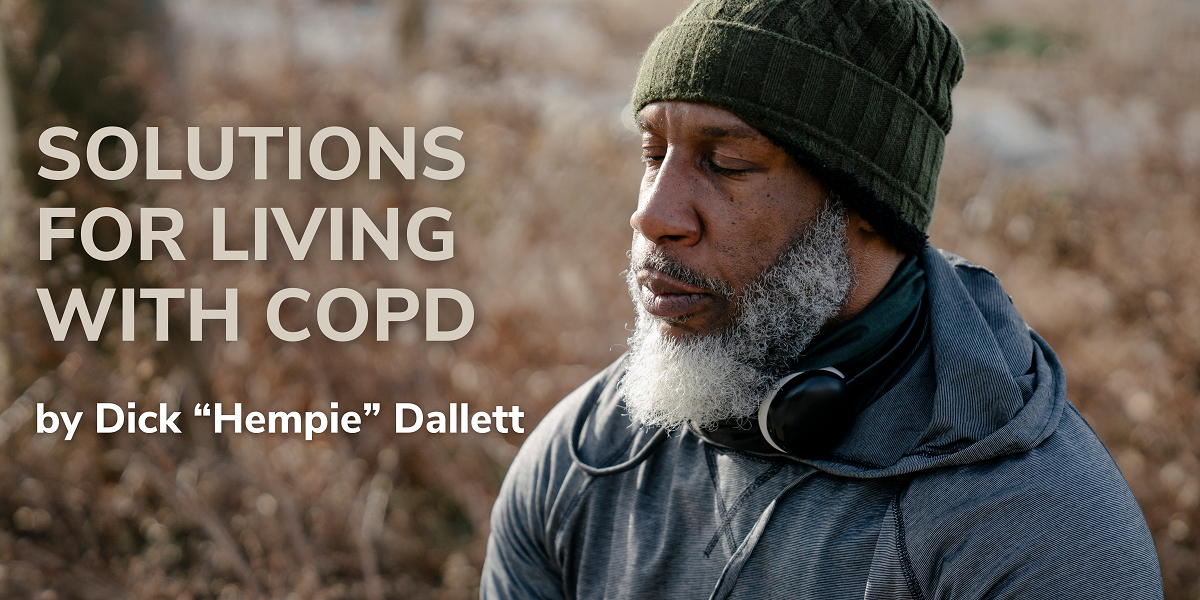Solutions for Living with COPD

I was diagnosed with COPD five years ago. Along the way I have developed ways to cope with this disease that have increased my longevity and the daily quality of my life. I’d like to share them with others, with you.
I’ll keep this as concise as I can, somewhere between bullet points and War and Peace. Humor is such a huge part of our lives that it can’t be ignored. Wordiness, run-on sentences, and overuse of big fancy words is redundant and ubiquitous, and I already rue this hypocritical, hyperbolic musing!
My number one goal throughout the day is to get as much oxygen to my brain as possible. This is no small feat, and I am not always successful. The lungs oxygenate the blood which delivers it to whatever part of the body calls for it. My lungs can no longer process the air, so I rely on a concentrator to give me more. When any body part calls for oxygen, it robs my brain of air, and my thinking becomes unclear. This is why I do the things I do. It’s a constant game of checks and balances. A little is good, but too much is bad. Searching the gray area between black and white is where we find the balance we need.
I was a carpenter for 50 years. Half a century of “get it done yesterday” has made it challenging for me to slow down. When I do, I am successful. I am absolutely amazed about how much focus and concentration it takes to accomplish a task while breathing correctly and moving in a slow and deliberate manner. I am just as amazed at what great results it provides when I do. Did you ever think roses and candles could save your life? Neither did I until I learned a few tips and tricks to mitigate some of the devastating symptoms of this disease.
Creative, out-of-the-box thinking can make a huge impact on our health and happiness. We need to adapt to a new way of doing business; after all, we are literally one letter away from “cope.” Hopefully my ideas and practices will help you but consider this a jumping off point to design your own program.
MORNINGS: Good mornings start with preparation the night before. I turn my oxygen level down to 2½ when I go to sleep to avoid CO2 build up in my blood due to inactivity. I have my inhalers, water, iced coffee and an O2 tank with a mask all ready to go. After our bodies are at rest for an extended period of time, getting things in gear is a tremendous shock to our system. As I lay in bed in the morning, waking up my internal dialogue is important. I say things to keep myself calm and avoid panic. I slowly get into my chair, remove my bi-pap mask, put on the O2 mask and turn it up to 10. Now I just breathe, thinking “roses and candles, roses and candles.” When my breathing is steady, I gradually wean myself down to 5. I use my Albuterol rescue inhaler, then the Spiriva. At this point I'm ready to switch to the nasal cannula. Coffee. Morphine sulfate. Coffee. Relaxing and calming myself. This whole process takes 20 to 25 minutes. Now, I'm ready to move. I stand up and get used to that. No sudden moves. Then I slowly walk to my concentrator and turn it up to 4½. Sit down and catch my breath. I listen to some meditative music and I’m now prepared to start my day.
WALKING: Plan your route inside your home as you go about your activities of daily living. Don’t deviate. You use less gas in a car by driving 30 mph for 60 minutes than you do driving 60 mph for 30 minutes. Same thing with walking. The slower the better. Even with months of practice, at times I speed up so I can sit down, and ultimately suffer with shortness of breath.
BREATHING: When we inhale through our nose, the air is warmed, moisturized, and filtered. When we exhale through our mouth, we are expelling CO2, and the more the better.
- Imagery is good here. I like to think of smelling a big, beautiful bouquet of roses. Taking big belly breaths through the nose. When I exhale, I picture myself blowing out the birthday candles on a large cake. I try not to think that there are 70 of them. The more extended the exhale, the more toxic CO2 is expelled. Watch a four-minute video on the You Tube channel by Dr. Andrew Huberman concerning the physiological sigh, which is a mechanism to reduce stress.
- Buy yourself “The Breather.” It's a small pipe-like device that strengthens all things breath related. There’s a neat, easy to use app that goes with it. There’s also a two-minute YouTube video on respiratory muscle training that’s helpful.
- Tension: I carry tension in my shoulders, jaw, and brow. So, if I’m winded and stressed, I recite my mantra: Shoulders-roses…caaandeeels…jawroses…caaaandeeels…Browroses…caaandeeels. Which is short for:
- Relax shoulders
- Slacken jaw
- Unfurrow brow
- Smell the roses
- Blow out the candles
The inhale is a bit slower than the exhale. It's a lot, but so is gasping for air and panicking to the point of having an exacerbation.
STAYING CALM: With COPD, it’s common to become panicky if something in your routine goes wrong, such as a snagged hose. To combat that, I practice imagery. In my mind, I put myself into a stressful situation—such as being surrounded by a cloud of angry, buzzing bees—and imagine staying calm in the midst of the chaos. Practicing this helps me stay calmer when a real stressful situation comes along.
SHOWERING: Taking a shower is one of the most intimidating things we deal with. Why wouldn’t it be? We’re in a confined space, there’s water involved and the thought of water around the cannula is scary. There is steam and humidity. These things alone are enough to cause stress, not to mention the vulnerability of being naked, exposed and possibly needing help. I get it!
Here’s what I did initially to face and meet this challenge. Preparation is the key. Get all your stuff in order: towels, clean clothes, and a place to dress. Get a shower chair, a hand-held shower head and a place to hang it. Turn on the water finding the coolest temperature you can tolerate, a bit warmer than what feels good on your hand. I have my setting marked with two dots of bright red fingernail polish. Sit on the edge of the tub and get used to the space with running water. Shut the water off, and fully clothed, sit on your shower chair and acclimate yourself to the space. Rub your legs and arms to test your strength tolerance. It’s a bit of work getting clean. Plan your entrance and exit from the tub. Which leg first. Do you have grab bars? Practice this until you’ve got it down to a science. Put on some shorts and go through your entrance-exit routine. Turn the water on and get used to the wetness. Water on, water off. Yes, Mr. Miagi. The less you have to think about the less freaked out you’ll be. I am pretty good at this but am tired and a bit panicky when it's over, even after all this time.
I have developed these practices over time and they work for me. Try my ideas and see how they work for you. Soon you’ll come up with your own personalized program. The more you stay in your routine and the less you have to think about oft-repeated activities, the more time you’ll have to control your breathing. That means more oxygen to your brain, which is the ultimate goal.
I hope this short guide about coping mechanisms helps you manage this horrible disease. Good luck!
Tagged:

